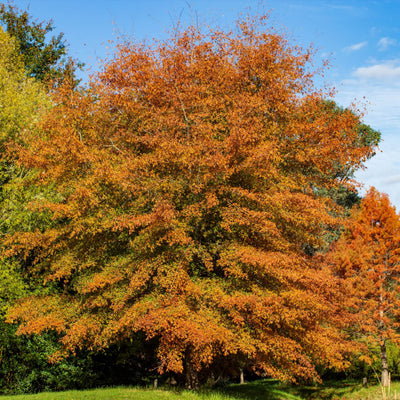Willow Oaks are elegant, impressive trees that are typically located along the banks of large streams and rivers. It is their height and form that make them most appealing for landscaping and other land use development. Being an oak and a member of the oak family, it has the bonus of beauty and function. If you are looking to plant this tree in your yard, or if you are simply gathering information about it, all you need is right here.
What Is A Willow Oak Tree?
Willow Oak trees are large, deciduous trees. They can reach heights of 40–60 feet and provide a canopy that spreads 30–40 feet. Apart from their height, these trees are impressive to behold year-round. They are highly praised for their light green foliage in the summer and the warm, dark red and brown highlights seen during the fall. Their leaves, often described as willow-like, are 8–10 inches long, which gives this tree a distinct appearance in a sea of other oak trees.
Basic Maintenance of a Willow Oak Tree
Willow Oak trees need basic attention and care. The following pointers should help:
-
Mulching: It is crucial to spread the mulch circularly around the trunk of the tree to retain moisture and reduce the chance of weeds. Be sure to remove some mulch in the middle of the circle to prevent trunk girdling.
-
Watering: During droughts, water deeply but avoid soaking the leaves. Watering the roots is critical to keeping the entire tree hydrated and in healthy condition.
-
Pruning: Willow Oaks do not require a lot of pruning. When necessary, pruning should be done in winter or early spring to avoid damaging the tree.
What About Sunlight?
Willow Oak trees love being in the sun. Be sure to plant them in an area that receives at least six hours of direct sunlight each day. A more ideal position would be eight hours of sunlight, which helps the tree grow stronger. On the other hand, a deficiency of sun would weaken the tree and hinder its growth.
Growth Habits of Willow Oaks
Taxonomists categorize Willow Oaks as deciduous trees since they shed their leaves every autumn. Due to the shedding of leaves in the fall, oaks require summer irrigation, especially in the latter months of the season.
Willow Oaks extend from Maine to Georgia in the eastern parts of the U.S. They also grow in parts of Central America, Mexico, and Southern Canada. These oaks require ample sunlight in conjunction with well-drained soil. They grow best when not densely planted with too many trees close to one another, as they need sunlight to thrive.
Is the Willow Oak Tree Poisonous?
No, Willow Oak trees are not poisonous, so they can be used in gardening and are safe for use around pets and children. However, be cautious with the leaves under the tree as they can become slippery when wet.
How Do You Care for Willow Oak Trees and How Do You Plant Them?
When planting a Willow Oak, make sure the tree has the right soil. Fill the planting hole with compost, as this helps the roots grow faster. Ensure the plant is watered regularly during the first few months after planting to help it settle in.
How Do You Plant a Willow Oak Tree?
To plant a Willow Oak tree, follow these steps:
-
Choose a location that gets full, direct sunlight and has well-draining soil.
-
Dig a hole about 6 inches deep and 3 feet wide.
-
Place the Willow Oak's roots in the center of the hole and cover it with dirt until the soil is level with the ground.
-
Water it thoroughly after planting to help the tree settle in.
By following these steps, the Willow Oak will develop well and thrive in its new location.
How Did the Willow Oak Tree Get Its Name?
The name "Willow Oak" comes from the tree's resemblance to the willow tree in its early stages of growth. Although it starts out with slender, elongated willow-like leaves, it eventually matures into a fully grown oak, which is robust and strong.
Visit TN Nursery for Your Willow Oak Tree!
If you're looking to add a Willow Oak tree to your landscape, visit TN Nursery. We offer a variety of healthy, well-cared-for trees, including Willow Oaks. Check out our full collection today and find the perfect addition to your garden!
FAQs About Willow Oak Trees
What is a Willow Oak Tree?
A Willow Oak tree reaches heights of 40 to 60 feet, is native to eastern North America, and is considered one of the larger oak trees, with a width span of 30 to 40 feet. During summer, its light green leaves turn a brownish hue in the fall. The long, willow-like leaves give it the name Willow Oak. This tree is commonly found along the banks of streams and rivers and is sought after for its beauty and durability.
What are the Cons of the Willow Oak Tree?
Willow Oaks are generally easy to maintain, but they have a few drawbacks. The dense canopy may block sunlight for smaller plants beneath it, and the leaves and acorns the tree sheds can create a mess in the garden. Additionally, Willow Oaks are more susceptible to certain diseases and pests, but with proper care, these issues are easy to manage.
What is Willow Oak Wood Good For?
Willow Oak wood is strong and durable, making it an excellent material for furniture, flooring, cabinetry, and construction. Its fine texture and smooth grain make it highly resistant to wear and tear, making it a popular choice for crafted items.
What is Another Name for Willow Oak?
Willow Oak trees are also known as Quercus phellos or Peach Oak. These names come from the tree's scientific classification and its youthful resemblance to the peach tree.
Why is the Willow Tree So Important?
Willow trees are renowned for their flexibility and beauty. Though the Willow Oak tree grows larger and sturdier than its smaller relatives, it still retains the grace of a willow. It stands out as a "genteel giant" and is a significant feature in any landscape due to its adaptability and long life.
Is Willow Oak Valuable?
Yes, Willow Oak trees are valuable in many ways. They add beauty to gardens and landscapes, providing shade, privacy, and habitat for wildlife. The timber of the Willow Oak is also used in the furniture and construction industries, adding to its value.




